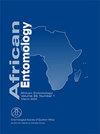Chrysomya chloropyga (copper-tailed blowfly) larvae reared on abattoir waste as a protein source for broiler production: carcass traits, meat quality and sensory attributes
IF 1.2
4区 农林科学
Q3 ENTOMOLOGY
引用次数: 0
Abstract
The larvae of the copper-tailed blowfly (Chrysomya chloropyga) have the potential to break down high-risk waste such as abattoir waste and ameliorate the nutrients to be reintroduced into the food chain by including them in broiler feeds. Chrysomya chloropyga larvae were grown on abattoir waste, harvested, processed, and included in broiler diets at inclusion rates of either 5, 10 or 15%. Thereafter the carcass traits, meat quality characteristics and descriptive sensory attributes were determined. Further to this the mineral content of the tibia, as well as the tibia bone strength were determined. The highest inclusion rate of 15% resulted in broiler carcass and meat characteristics that were on par with a formulated soya-based control diet. The chemical composition of the meat was predominantly not significantly affected by the dietary larval meal inclusion (p > 0.05). In terms of its sensory attributes, meat from broilers fed C. chloropyga meal showed some significant differences for chicken aroma and initial juiciness (p ≤ 0.05). However, no significant differences were observed for any of five other sensory attributes of importance. Interestingly, the dietary inclusion of C. chloropyga meal was significantly related to increased tibia potassium and iron content, which could be linked to the insects’ accumulating these minerals present in the abattoir waste. The results indicate that C. chloropyga larval meal could be included in broiler diets at up to 15% without any negative effects on the aforementioned characteristics and could even influence them positively.将屠宰场废弃物作为肉鸡生产的蛋白质来源饲养铜尾锦蝇幼虫:胴体特征、肉质和感官属性
铜尾粉虱(Chrysomya chloropyga)幼虫具有分解高风险废弃物(如屠宰场废弃物)的潜力,通过在肉鸡饲料中添加铜尾粉虱(Chrysomya chloropyga)幼虫,可改善食物链中的营养成分。在屠宰场废弃物上培育绿僵菌幼虫,收获、加工并以 5%、10% 或 15%的添加率添加到肉鸡日粮中。随后测定了肉鸡的胴体性状、肉质特征和描述性感官属性。此外,还测定了胫骨的矿物质含量和胫骨骨强度。最高添加率为 15%时,肉鸡的胴体和肉质特征与以大豆为基础的对照日粮相当。肉的化学成分主要不受日粮中幼虫粉添加量的显著影响(p > 0.05)。在感官属性方面,饲喂 C. chloropyga 幼虫粉的肉鸡的肉在鸡肉香味和初始多汁度方面有显著差异(p ≤ 0.05)。然而,在其他五种重要感官属性中均未观察到明显差异。有趣的是,膳食中添加 C. chloropyga 粉与胫骨钾和铁含量的增加有显著关系,这可能与昆虫在屠宰场废物中积累这些矿物质有关。研究结果表明,在肉鸡日粮中添加高达 15%的 C. chloropyga 幼虫粉不会对上述特征产生任何负面影响,甚至会产生积极影响。
本文章由计算机程序翻译,如有差异,请以英文原文为准。
求助全文
约1分钟内获得全文
求助全文
来源期刊

African Entomology
生物-昆虫学
CiteScore
2.00
自引率
0.00%
发文量
17
审稿时长
6-12 weeks
期刊介绍:
African Entomology (ISSN 1021-3589 – print / 2224-8854 – online) replaced the old Journal of the Entomological Society of Southern Africa in 1993. A single volume consisting of two issues (March and September) is published annually. The journal is indexed in all major abstracting journals
African Entomology is a peer reviewed scientific journal that publishes original research articles and short communications on all aspects of entomology, with an emphasis on the advancement of entomology on the African continent.
 求助内容:
求助内容: 应助结果提醒方式:
应助结果提醒方式:


